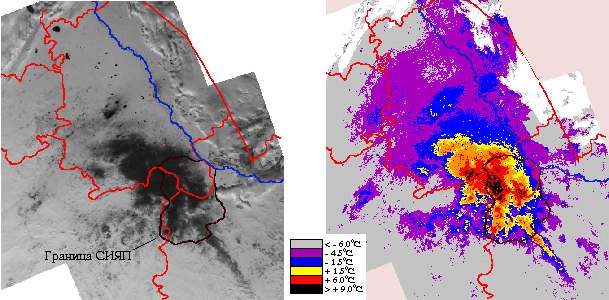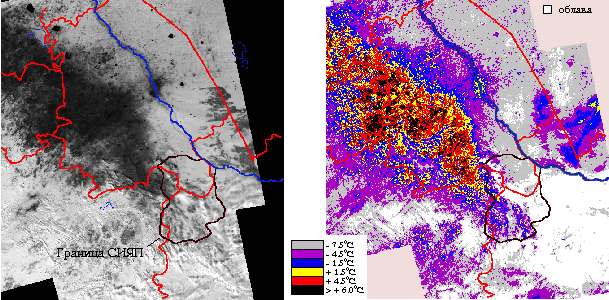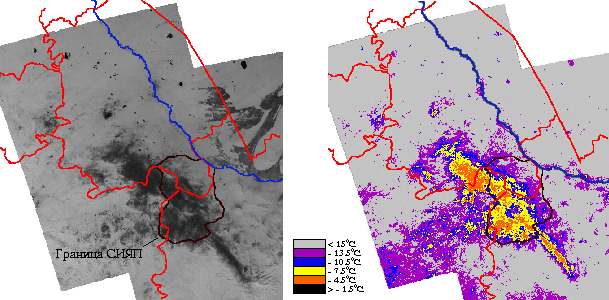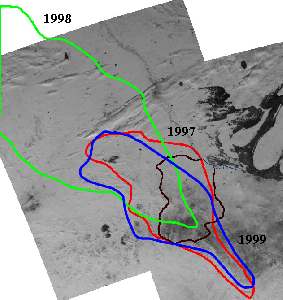| Since 1996 Space Research Institute of the Ministry of science and Higher Education (SRI) conducts regular monitoring and operative mapping of Kazakhstan territory using the remote sensing data from the NOAA satellites. Both snow cover maps for the winter period and vegetation state and surface temperature maps for warm season are formed. In February, 1997 the large snowless zone in the area of Semipalatinsk Test Nuclear Site (STNS) was fixed by images in the visible band (see fig.1). The thermal infrared (IR) (band 4) data has allowed to allocate a few sectors with higher (more than 10oC) temperature in the zone center (see fig.2). In March the configuration of thermal anomalies essentially did not change. Zone of higher temperature disappeared when air temperature had increased and a ground surface had warmed up higher than 25oC. It is necessary to note, that in places of the temperature anomaly the vegetation was almost absent during all verdure season. In the autumn the obviously expressed temperature anomalies were not found. | ||||
| Fig.1-2. Condition of snow cover and temperature field of STNS region by NOAA/AVHRR data (17 February 1997), channels 2, 4. | ||||
 |
||||
| In 1998 the picture of temperature fields in SNTS was strongly deformed by the most powerful center of the future drought generated on common borders of Pavlodar, Akmola and North-Kazakhstan oblasts at the end of February. To middle of March it covered an extensive zone in northeast of Kazakhstan, switching the polygon territory (see fig. 3 and 4). | ||||
| Fig.3-4. Condition of snow cover and temperature field of STNS region by NOAA/AVHRR data (12 March 1997), channels 2, 4. | ||||
 |
||||
| In 1999 the work of temperature mode monitoring in SNTS region was continued. The results of temperature fields mapping have confirmed presence of steady temperature anomalies (see fig. 5 and 6). | ||||
| Fig.5-6. Condition of snow cover and temperature field of STNS region by NOAA/AVHRR data (7 March 1999), channels 2, 4. | ||||
 |
||||
| It is necessary also to note amazing similarity of dynamics of development and configuration of snowless zones in 1997 and 1999. The similar contours are looked through on space image for 14.02.1996 (see fig. 7). Similarity is becomed even more evident at spatial overlapping of borders snowless zones constructed on shootings 1997, 1998 and 1999. | ||||
| Fig. 7. Condition of snow cover of STNS region (14 February 1996) and contours of zones without snow by NOAA/AVHRR data for 1997, 1998, 1999 y.y., channel 2. | ||||
 |
On basis of abovestated facts it is possible with
confidence to assert that SNTS is in a zone of increased temperature activity. Early
appearance of snowless zone and high temperature of ground surface are most likely as
consequence of deep thermal processes, probably, initiated by numerous nuclear explosions
(Appendix 1). It is necessary to note some
deep breaks pass through territory of SNTS. And, as it is known, the underground
explosions are capable to change the geological environment. |
|||
Space Research Institute (SRI) searches for the
partners wishing to take part in complex monitoring of a temperature mode in SNTS
territory and adjoining areas and also the sponsors ready to finance these works (see Appendix 2).
|
||||